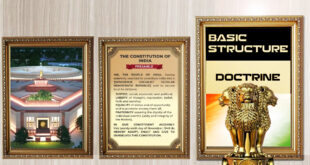The BJP is giving up seats it won in Bihar to JD(U), a strategy that is not without its risks
It is easier to reach agreements in principle than to sign up on the specifics, but both the Bharatiya Janata Party and the Janata Dal (United) overcame a major hurdle when they decided they will contest an equal number of the 40 seats in Bihar in next year’s Lok Sabha election. There is no word yet on what that number will be, as there are two other alliance partners in the equation, the Lok Janshakti Party of Ram Vilas Paswan and the Rashtriya Lok Samata Party of Upendra Kushwaha. In 2014, the NDA partners won 31 seats — BJP 22, LJP six, and RLSP three. The JD(U), which contested separately, won just two seats, but now wants to be treated as a senior partner of the alliance, having won about 16% of the vote in the 2014 Lok Sabha election and the 2015 Assembly election. What this means in real terms is that the BJP will have to stand in fewer seats than it won in 2014. Unless it manages to beat down the LJP’s expectations, the BJP will not be able to contest in more than 16 seats. The JD(U) has not been a reliable ally, not for the BJP, and not for the Rashtriya Janata Dal and the Congress. To give up seats it now holds to an ally not wholly trustworthy is a gamble, but the BJP realises the situation is vastly different from what obtained in 2014. In the 2015 Assembly election, the BJP’s seat share dropped substantially in the face of a JD(U)-RJD-Congress alliance that polarised votes. The BJP was unable to come to power until after the JD(U) broke away from the RJD and the Congress and re-joined the NDA. It was a hard lesson, but it was learnt well. A humbled BJP evidently thinks it wiser to be more accommodative to allies than to pursue the high-risk strategy of trying to force multi-cornered contests in the hope of coming on top in the first-past-the-post system. If the agreement reached by BJP president Amit Shah and Chief Minister Nitish Kumar sticks, the electoral arithmetic will likely favour the NDA. But the RJD is clearly on a comeback trail, and the image of Chief Minister Kumar is much the worse for his years in power. The vote shares of the NDA constituents might not all neatly add up. In the opposing camp, the problem is not seat-sharing but putting together a winning combination. The RJD and Congress must be hoping that Mr. Kumar, after his frequent shifting of camps, will not be able to take his entire support base to the NDA. A better showing in the by-elections was a morale-booster, and the RJD and the Congress might fancy their chances as they contend with the formidable numbers of the NDA.
Source : https://www.thehindu.com/todays-paper/tp-opinion/more-from-less/article25355685.ece
Check Also
Joint Parliamentary Committees (JPCs): Scrutinizing the Executive
Introduction In a parliamentary democracy, ensuring accountability of the executive is paramount. Joint Parliamentary Committees …
 Chinmaya IAS Academy – Current Affairs Chinmaya IAS Academy – Current Affairs
Chinmaya IAS Academy – Current Affairs Chinmaya IAS Academy – Current Affairs



